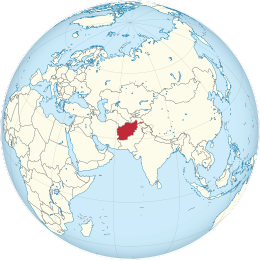Commons:Urheberrechtsregeln nach Gebiet/Afghanistan
|
Urheberrechtsregeln: Afghanistan Kürzel: COM:AFGHANISTAN | |
 | |
 | |
| Schutzfrist | |
|---|---|
| Standard | Leben + 50 Jahre (afghanischer Kalender) |
| Fotografie | Veröffentlichung + 50 Jahre |
| Anonym | Veröffentlichung + 50 Jahre |
| Audiovisuell | Veröffentlichung + 50 Jahre |
| Posthum | Veröffentlichung + 50 Jahre |
| Andere | |
| Panoramafreiheit | Nein |
| Gemeinsame Lizenzvorlagen |
{{PD-old-auto}} {{PD-Afghanistan}} |
| ISO 3166-1 alpha-3 | AFG |
| Abkommen | |
| Berner Übereinkunft | 2. Juni 2018 |
| Welthandelsorganisation-Mitglied | 29. Juli 2016 |
| URAA-Wiederherstellungsdatum* | 29. Juli 2016 |
| WIPO-Urheberrechtsvertrag | 9. Februar 2021 |
| *Ein Werk ist in der Regel in den USA geschützt, wenn es sich um eine Art von Werk handelt, das in den USA urheberrechtsfähig ist, nach 31 December 1928 veröffentlicht wurde und im Ursprungsland am URAA-Datum geschützt ist. | |
Diese Seite gibt einen Überblick zu den Urheberrechtsbestimmungen in Afghanistan insofern diese für das Hochladen von Werken in die Wikimedia Commons relevant sind. Beachte, dass jedes aus Afghanistan stammende Werk sowohl in Afghanistan, als auch in den vereinigten Staaten gemeinfrei sein, oder unter einer freien Lizenz erhältlich sein muss, bevor es in die Wikimedia Commons hochgeladen werden kann. Wenn der Urheberrechtsstatus eines Werks aus Afghanistan zweifelhaft ist, ziehe die entsprechenden gesetzlichen Bestimmungen zu Rate.
Hintergrund
Afghanistan kam im späten 19. Jahrhhundert unter eine lose britische Oberhohheit. Nach dem dritten Anglo-Afghanischen Krieg 1919 erlangte das Land seine Unabhängigkeit. Seitdem wurde es von Staatsstreichen, Invasionen und Bürgerkriegen heimgesucht.
Afghanistan has been a member of the World Trade Organization since 29 July 2016, the Berne Convention since 2 June 2018 and the WIPO Copyright treaty since 9 February 2021.[1]
As of 2018 the World Intellectual Property Organization (WIPO), an agency of the United Nations, listed the 2008 Law Supporting the Rights of Authors, Composers, Artists and Researchers (Copyright Law) as the main IP law enacted by the legislature of Afghanistan.[1] WIPO holds the text of this law in their WIPO Lex database.[2]
The Taliban government since 2021 is unrecognized, but continues to enforce existing copyright law.
Dauer
Under the 2008 Copyright Law, protection is as follows:
- Works published or broadcast during the life cycle of the author shall be protected 50 calendar years after his/her death unless the author has decided differently.[2008 Article 16.1.1]
- Joint works published or broadcast during the life cycle of the authors shall be protected for 50 years after the death of the last author.[2008 Article 16.1.2]
- Works published or broadcast with metaphorical (pseudonym) names shall be protected for 50 years after the first year of the publication.[2008 Article 16.1.3]
- Works not published during the life cycle of the author and in the case of the joint work, that have not been published during the life cycle of the last author, shall be protected for 50 years effective from the first year of publication and broadcast.[2008 Article 16.1.4]
- Audiovisual works shall be protected for 50 years effective from the first year of the publication or broadcast.[2008 Article 16.1.5] If the work is not published or broadcast, it shall be protected for 50 years from fixation.[2008 Article 16.2]
- Photography and painting works shall be protected 50 years effective from the first year of publication and broadcast.[2008 Article 16.1.6]
Folklore
Public Culture (National Folklore) is an expression which include characterized principles of traditional artistic heritage originated or developed by a group of people in the State which reflect their artistic heritage and include the following expressions: Oral expressions such as tales, popular poetry and riddles; Musical expressions: include popular songs accompanied by music or without music; Motion expressions, include popular Atans (national dance), plays and other special popular artistic and ritual forms; Identical expressions such as products or popular art such as drawings with lines and colors, engravings, statuary, pottery, needlework, woodwork, mosaic, metalwork, jewelry, knitting, carpet weaving and other textiles; Musical instruments; Different architectural works.[2008 Article 3.23]
National folklore shall be the public property of the State, the Ministry of Information and Culture, shall protect National Folklore by all legal means.[2008 Article 45]
Lizenzvorlagen
Siehe auch: Commons:Lizenzvorlagen
- {{PD-Afghanistan}} – Public Domain (kein geltendes Urheberrecht)
Panoramafreiheit
Siehe auch: Commons:Panoramafreiheit
![]() Nicht OK, nur für den persönlichen Gebrauch
Nicht OK, nur für den persönlichen Gebrauch
Article 39 permits reproductions of published works "for personal use only". Article 40 only allows noncommercial uses of extracts of works for teaching purposes. Article 42 is a close provision that allows "the press or other information media" to publish "works displayed openly to the public, provided that the name of the author is clearly indicated," but the types of works are restricted to "speeches, lectures, as well as legal proceedings or similar works," not architectural works or statuaries.
Schöpfungshöhe
Siehe auch: Commons:Schöpfungshöhe
According to the 2008 Copyright Law, work that may be protected includes: Photography work that has been created using an innovative mode; Innovative work of handicraft or industrial art (carpet designs, rugs, felt carpet and its attachments etc.); Innovative work which has been created based on the public culture (folklore) or national cultural heritage and art.[2008 Article 6(1) items 7-9]
Briefmarken
Siehe auch: Commons:Briefmarken
![]() Copyright expires 50 years after first put in circulation.[2008 Article 16.1.6]. For stamps published more than 50 years ago (before 1 January 1974) use {{PD-Afghanistan}}.
Copyright expires 50 years after first put in circulation.[2008 Article 16.1.6]. For stamps published more than 50 years ago (before 1 January 1974) use {{PD-Afghanistan}}.
Siehe auch
Zitate
- ↑ a b Afghanistan Copyright and Related Rights (Neighboring Rights). WIPO: World Intellectual Property Organization (2018). Retrieved on 2018-11-08.
- ↑ Law Supporting the Rights of Authors, Composers, Artists and Researchers (Copyright Law). Afghanistan (2008). Retrieved on 2018-11-08.